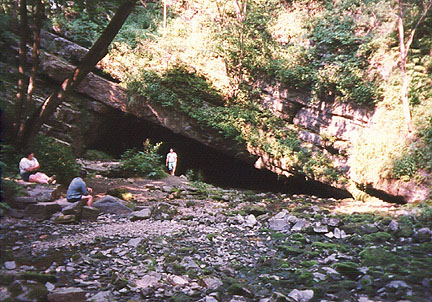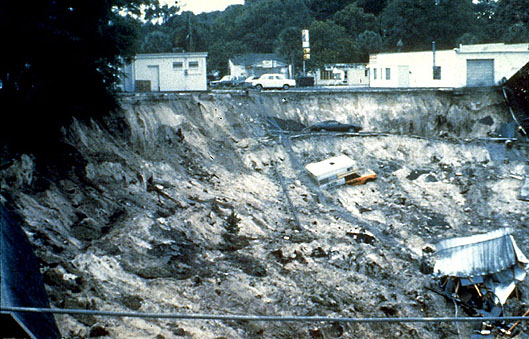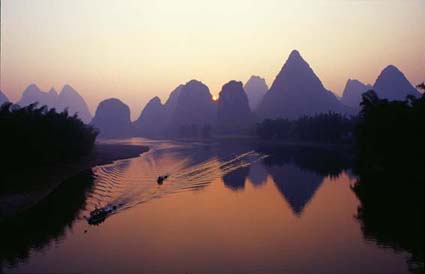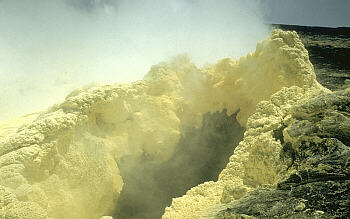Geography 111:
Introduction to Physical Geography and Environmental Studies
...to Geog 111 Main Page and Course Description
...to Geog 111 Syllabus
...to Geog 111 Course Schedule and Lecture Outlines
...to Geog 111 Course Project
Geog 111 Lecture Outline: Karst and Hydrothermal Processes
Update: 10/8/05
Introduction
McKnight 9.5: Hydro Cycle
Fluvial Processes: overland vs stream flow
- 1. Impact of Fluvial Processes on the Landscape
- 2. Fundamental Definitions and Concepts of Fluvial Processes
- 3. Stream Channels: Key Characteristics of individual streams and rivers
- 4. Stream Systems: how streams and rivers relate to each other
- 5. Shaping and Reshaping of Valleys by Fluvial Processes
Karst and Hydrothermal Processes
- underground water also has an effect on landforms
1. Karst Processes and Landscapes
- Related to chemical weathering: how?
- Map: Mammoth Cave KY 1:62k scale
- Map: Lake Wales FL 1:24k scale
2. Hydrothermal Processes and Landscapes
- Related to internal processes: how?
1. Karst Processes and Landscapes
- Water: a solvent of certain rock forming chemicals
1a. Solution and Precipitation
- Pure water: not a good solvent: but most underground water not pure
- Underground water: a weak solution of carbonic acid
- it contains dissolved carbon dioxide gas
- Water can have chemical reaction with and break down many types of rock
- Limestone composed largely of calcium carbonate: reacts with underground
water to produce calcium bicarbonate which is very soluble in water
and easily removed by water
- Water percolating down through limestone causes a chemical reaction
- the rock is dissolved and carried away in solution
- the moister the climate the larger the effect
- bedrock structure important: more joints and faults and bedding planes
(between layers of strata) = more effect
- The effects are below and at the Earth's surface.
1b. Caverns and Related Features
McKnight 17.2: Cave Features
Caverns: solution cavities large enough for a human to get into
- usually more horizontally expansive then vertically expansive
- why
Speleothems: Cave Deposits (from water)
- two stages in cavern formation: excavation and decoration
- speleothems:
- stalactites:
- stalagmites:
- pillars:
Biosphere underground...
Karst and Cave WWW Sites:
1c. Karst Topography
Karst region in the former Yugoslavia: gave its name to areas of landforms
(and related processes) shaped by dissolution of limestone (or a few other highly
soluble rocks) at the earth's surface
- WWW) Akademski Speleolosko-Alpinisticki Klub
McKnight 17.6: Major Limestone and Karst Regions in the World

- Map of Karst Regions in the USA
McKnight 17.7a: Development of Karst Landscape
- early: solution cavities and caves forming in limestone underground
- surface drainage: usually minimal or unorganized

- Tytoona Cave, PA (Mid-Atlantic Karst Conservancy)
Sinkholes: dolines: typically occur at joint intersections, weak spots in limestone

- Collapse Sinkhole/Doline in Florida
- sinkhole size:
McKnight 17.7b: Development of Karst Landscape
- mid-level evolution of Karst landscape
- sinkholes channel water into ground:
- uvala: networks of related sinkholes
McKnight 17.7c: Development of Karst Landscape
- late in the development of a Karst landscape
- tower karst or mogotes:


- South-Eastern China (also Vietnam, Western Cuba)
2. Hydrothermal Features
Hydrothermal features are also impressive
- but occur in a much more limited area on the Earth's surface
Underground water heated by magma then forced to earth's surface
- very localized features; leave only small imprint on earth's surface
- occur in areas of Iceland, New Zealand, Chile, Siberia, and US (Yellowstone)
McKnight 17.A: East West Cross Section of Yellowstone
- water seeps in from above: heated, expelled
4a. Hot Springs
McKnight 17-10: Hot Springs
- precipitates out of water when water reaches surface, leaving deposits
McKnight 17.C: Jupiter Terrace at Mammoth Hot Springs
McKnight 17.D: Mammoth Hot Springs in Yellowstone
- terraces: if hot spring opens onto slope
4b. Geysers
McKnight 17.12a: Old Faithful in Yellowstone National Park
- eruption of heated water from underground
- water accumulates in underground caverns
- eruptions depend on enough water accumulating
McKnight 17.13: (only in textbook) Lone Star Geyser: Nozzle
- some geysers develop depositional features; most are not substantial
4c. Fumaroles
- surface crack (joint, fault) directly connected to a deep heat source

- Fumarole in Hawaii (USGS)
- water instantly converted to steam and expelled constantly; no eruption
Sum: Effect of Underground Water on Landforms
1. Karst Processes and Landscapes
- related to chemical weathering
- relatively widespread effect on earth's surface
1a. Solution and Precipitation
- water as a solvent
- chemical reaction with limestone
1b. Caverns and Related Features
- Caverns: solution cavities large enough for a human to get into
- Speleothems: Cave Deposits (from water)
1c. Karst Topography
- development of Karst landscape
- sinkholes, uvala, tower karst or mogotes
2. Hydrothermal Features
Underground water heated by magma then forced to earth's surface
- very localized features; leave only small imprint on earth's surface
4a. Hot Springs
- phenomena and deposits: terraces, domes, cones
4b. Geysers
- eruption of heated water from underground
4c. Fumaroles
E-mail: jbkrygier@owu.edu
...to Geog 111 Main Page and Course Description
...to krygier teaching page.
...to krygier top page.
OWU Home
OWU Geology and Geography Home






